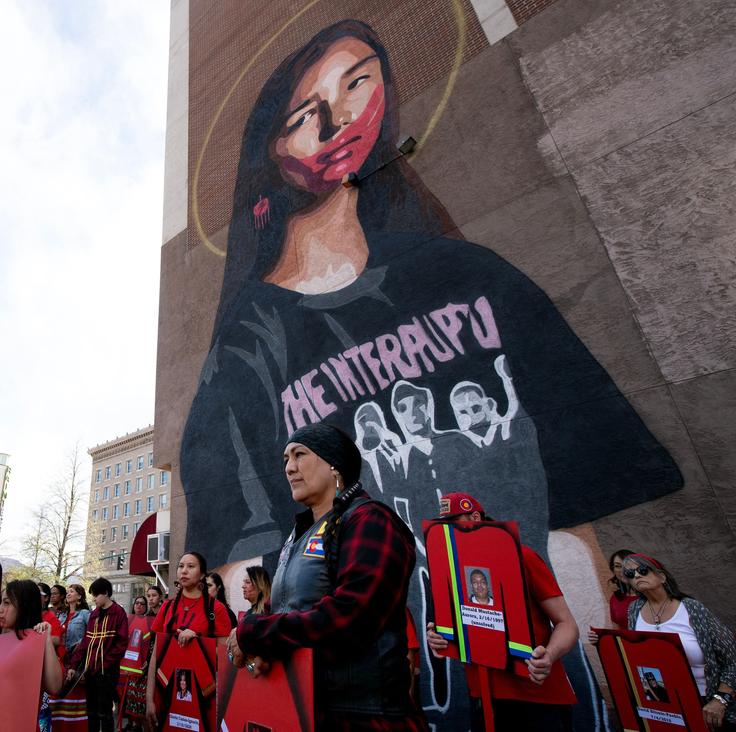Over the past few years, there’s finally been more light shed on the thousands of missing and murdered Native Americans and Alaska Natives whose stories have gone underreported and uninvestigated, devastating Native families and communities. The disturbing trend, which predominantly impacts women and children, sparked the Missing and Murdered Indigenous Women movement, led by organizers who paint red handprints on their mouths to symbolize their solidarity with affected families. The movement has gained tons of awareness, thankfully, due to posts on TikTok.
This week, the Department of Justice finally decided to take action on addressing this crisis. On Wednesday, it announced plans to assign lawyers to a new initiative, called the Missing or Murdered Indigenous Persons Regional Outreach Program, whose sole purpose is to investigate the disappearances and murders of North American Indigenous people.
The murder rate of Native women living on reservations is 10 times higher than the national average, making homicide the third-leading cause of death for Native women.
Days before the DOJ’s announcement, HuffPost reported on the conviction of a Nevada man who murdered his pregnant girlfriend, Amanda Davis, at her home in 2020. Before Davis was killed, her 8-year-old and 15-year-old children reportedly attempted to protect the woman from her partner turned attacker. Davis’ three kids were still at the home when police arrived and found her dead in a bedroom.
Davis’ story is an example of how little attention goes to the brutal erasure of Native American women. This lack of awareness has always come across as apathy from the media, local police and federal law enforcement, as Native American families search for their loved ones without much support from anyone else.
Hopefully, we’re on the precipice of change. According to the DOJ, its newly assigned attorneys will join on-the-ground investigations in regions of New Mexico, Arizona, Alaska, Washington, Oregon, Oklahoma, South Dakota, Michigan and Minnesota.
Though the true number of missing and murdered Native people is still unclear, the Bureau of Indian Affairs says there are 1,500 Native American and Alaska Native missing people in the FBI’s National Crime Information Center database. Also, roughly 2,700 cases of murder and nonnegligent homicide with Native American and Alaska Native victims have been reported to the government’s Uniform Crime Reporting Program.
However, the Bureau of Indian Affairs further says that 4,200 missing person and murder cases have gone unsolved, largely due to a lack of investigation amid confusion over jurisdiction and limited resources. This estimate is truly just the tip of the iceberg, given that many cases go unreported.
Under the supervision of the DOJ’s new program, five attorneys and five coordinators will help provide support in existing cases and ones that continue to arise. During a recent hearing in New Mexico led by the government’s Not Invisible Act Commission — a group of Native leaders, law enforcement officials and community members assigned to develop recommendations for the DOJ on missing, murdered and trafficked Native people — family members told the tragic stories of victims, some who disappeared years ago.
Among the commission members who spoke was educator Patricia Whitefoot of the Yakama Nation, whose sister disappeared in the ’80s. After decades without answers, a recent DNA test revealed that her sister’s remains had been located in a remote area of their reservation. Whitefoot echoed deep frustrations shared by many families who say that a major issue when loved ones go missing is inconsistent communication from law enforcement.
During our lifetimes, we’ve all witnessed the outrage, morbid curiosity and grief that results when white women disappear or are murdered. All humans who suffer in this way deserve that same attention.
We also just experienced nonstop coverage of the Titan submersible, a vessel that disappeared during a tourist expedition to see the sunken Titanic. The urgency around missing Native people should match the media and government efforts put toward finding Titan’s five wealthy passengers.
For now, the Not Invisible Act Commission will continue to work with Native communities to develop further recommendations, which will be put in a report due to the DOJ in October. While solutions continue to materialize, we’ll consider this a stepping stone that hopefully leads to some justice.

